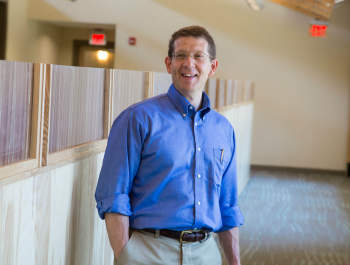Image

Jim King, President and CEO, Fahe
Challenge: Central Appalachia had an estimated 100,000 units of substandard or overcrowded housing. Housing nonprofits serving the area could only produce 2,000 units annually. The organizations thus needed to change the way they did business to meet the challenges in the impoverished region.
Appalachia is one of the poorest regions in the country and poses considerable challenges to the nonprofits seeking to improve conditions in the struggling communities. In 2003, Central Appalachia had an estimated 100,000 units of substandard and overcrowded housing. Seventeen percent of homeowners and 33 percent of renters were cost burdened, paying more than 30 percent of their income on housing.
At the time, Fahe, a network of over 50 nonprofits, was producing 2,000 units of housing per year. Fahe President and CEO Jim King realized that while the network’s mission was strong, the scale of its production was not adequate to meet the housing challenges within a reasonable timeframe. To address the growing number of subpar housing units, Fahe had to change the way it did business.
Fahe is based Berea, KY, and is dedicated to eliminating persistent poverty in Appalachia. The network serves communities across the Appalachian portion of Kentucky, Tennessee, West Virginia, Virginia, Alabama and Maryland. The organizations use their expertise in finance, collaboration, innovation, advocacy and communication to achieve a more prosperous Appalachian region. Key to attaining this goal is providing leadership, housing, education, health and social services and economic opportunity. Fahe empowers the region’s communities of Appalachia with the resources, opportunities and tools needed to build a better life. Their strength in numbers creates positive change in Appalachia, one of the poorest and most difficult regions of the country to serve.
One of the challenges of leading a collective organization such as Fahe is that when a difficult change is required, everyone needs to be committed for the effort to be successful. Strong leadership is necessary to convince people of the need and of their potential for success to find a solution that fits the situation. At this time, King was in touch with other national organizations that were similar to Fahe but were achieving greater results. He realized that Fahe needed to find a way to grow through structured reorganization.
King knew that if he told the members that he thought they were failing at their mission, it would cause unnecessary tension and turmoil. Instead, he framed the problem as a question that would invite self-examination. Working with outside advisors and other key Fahe leaders, he asked if members felt that the network’s current response to the housing issue had the potential to fix the problem.
 Another part of the solution was challenging members to become more productive. The Network committed to increasing the production numbers from 2,000 units per year to 8,000 units annually between 2005 and 2015. While hitting the targeted number would, of course, be a great benefit to the people in Appalachia, setting such an ambitious number also served to show the members what they were truly capable of. Even if they didn’t hit the 8,000 mark, it was ambitious enough and it would help members learn that they could achieve more than expected. Attempting to meet the challenge would empower them to push themselves and stop playing so safely.
Another part of the solution was challenging members to become more productive. The Network committed to increasing the production numbers from 2,000 units per year to 8,000 units annually between 2005 and 2015. While hitting the targeted number would, of course, be a great benefit to the people in Appalachia, setting such an ambitious number also served to show the members what they were truly capable of. Even if they didn’t hit the 8,000 mark, it was ambitious enough and it would help members learn that they could achieve more than expected. Attempting to meet the challenge would empower them to push themselves and stop playing so safely.Finally, a key part of the solution was to establish systems that would support the reach for scale and help ensure success. Fahe created the Berea Performance Compacts framework to provide members with a structure that supported collaboration and the delivery of products and services more efficiently at greater scale. Each participating group in a compact had a strong set of skills, so instead of duplicating services and infrastructure, members would build on one another’s strengths. The first compacts focused on loan servicing, manufactured housing, multi-family housing, cooperative purchasing and volunteer management. The compacts also required members to break out of their isolation and work together which allowed them to share their core competencies, divest administrative functions, decrease costs and increase efficiency without sacrificing impact.
The challenge and the support of the Berea Compacts was a success. In 2014, a year ahead of the challenge deadline, the Fahe Network produced 8,725 units of housing. During the 10 years of the challenge, over 51,000 units were produced which brought in an additional value of over $1.9 billion.
The experience of successfully meeting this challenge proved to the Members that they could accomplish more by working together than apart. Those who initially doubted the ability to conquer such an ambitious goal had their opinions shifted over time as they experienced real progress year after year. Now, with their new goals and strategic plan in place, instead of meeting new challenges with doubt, the Members meets these new opportunities with boldness and a desire to push the limits of what they can accomplish for the people of Appalachia.
This project illustrates three important lessons learned:
- It is possible through planning and collective effort to meet ambitious goals
- A leader can ask an organization and its Members to do more than they may think is possible
- Working together in collaboration greatly strengthens the resources and possibilities for success.

